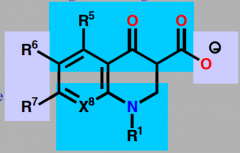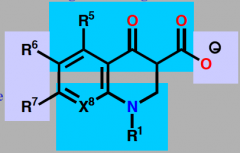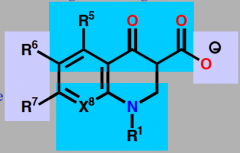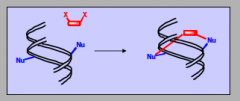![]()
![]()
![]()
Use LEFT and RIGHT arrow keys to navigate between flashcards;
Use UP and DOWN arrow keys to flip the card;
H to show hint;
A reads text to speech;
30 Cards in this Set
- Front
- Back
|
what does proflavine target? and how does it do so? |
bacterial DNA, it is an intercalating agent |
|
|
What does dactinomycin target? how does it do so? |
intercalates DNA (used for chemo) intercalator of the minor groove, blocks transcription and unwinding |
|
|
why is proflavine not recommended for systemic use? |
too toxic |
|
|
what does doxorubicin target? how does it do so? |
intercalates DNA (chemo, topo poison), blocks topo II by stabilizing DNA-enzyme complex |
|
|
What does Bleomycin target? how does it do so? |
intercalates DNA ( chemo ), radical formation & chain cutting, prevents DNA ligase from repairing damage |
|
|
What do etoposide and teniposide target? and how? |
stabilizes DNA - topo enzyme complex ( chemo, topo poison), causes chain cutting |
|
|
What does camptothecin target? and how? |
stabilizes DNA and topo I, ssBs and dsBs, used for chemo- it is a topo poison |
|
|
What do Quinolones and fluoroquinolones target? and how? |
antibacterial, stabilize bac DNA and topo. Four molecules stack in bound complex |
|

this is a quinolone, what does the O- bind to? |
binds to topoisomerase |
|

This is quinolone. Which domain is responsible for stacking? |
the bottom one |
|

This is quinolone. Which domain is responsible for DNA binding? |
top one |
|

This is quinolone. Which domain is responsible for Topo binding? |
right and left |
|
|
What is an alkylating agent? |
Alkylating agents are a class of chemotherapy drugs that bind to DNA and prevent proper DNA replication. They have chemical groups that can form permanent covalent bonds with nucleophilic groups (Nitrogens in Bases) in the DNA. |
|
|
show intrastrand crosslinking |

|
|
|
show interstrand crosslinking |

|
|
|
What type of agent is chlormethine? and what does it do? |
alkylating agent, that causes intra- and inter-strand cross-linking, preventing replication |
|
|
What type of agent is nitrosourea? and what does it do? |
nitrosourea decomposes in the body to form an alkylating agent and a carbamoylating agent |
|
|
What bases does nitrosourea crosslink? |
G-G and G-C |
|
|
what does the carbamoylating agent from nitrosourea react with? |
lysine residues on proteins |
|
|
What kind of agent is Busulfan? |
it is an alkylating agent, crosslinks DNA |
|
|
Dacarbazine, what kind of an agent is it? what is it activated by? what does it act on? |
it is an alkylated agent that is activates by demethylation in the liver, alkylates guanine groups |
|
|
what kind of an agent is mitomycin C? |
it is an alkylating agent, and one of the most toxic anticancer drugs in clinical use |
|
|
what type of a drug is cisplatin? |
it is a metallating agent that is a prodrug |
|
|
how does cisplatin work? what types of crosslinks, intra or inter? |
platinum covalently links to chloro substituents, binds to DNA in G rich units. causes intrastrand crosslinks |
|
|
How do chain cutters work? |
generate DNA diradical which results in oxidative cleavage of DNA |
|
|
how does a chain terminator work? |
the drug is added to the growing DNA chain and becomes covalently bonded. Usually, you would have a OH present at the 3' end, but with a chain terminator you would only have a Hydrogen at the end of the chain. |
|
|
what are some advantages of antisense therapy |
enzyme inhibitor, highly specific (17+ nts), smaller doses, less side effects |
|
|
what are some disadvantages to antisense therapy |
-you need exposed mRNA |
|
|
what are some advantages of miRNA? |
-potential for gene therapy -more efficiency than antisense |
|
|
what are some problems with miRNAs? |
- need to be metabolically stable |

